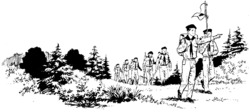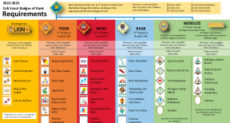 Suppose that instead of a usual weekend campout, the Scouts of your troop have decided to go on a weekend hike – maybe to get a taste of what a longer voyage like a Philmont trek might be like.
Suppose that instead of a usual weekend campout, the Scouts of your troop have decided to go on a weekend hike – maybe to get a taste of what a longer voyage like a Philmont trek might be like.
They’ll start out by getting dropped off Friday night, hike to their first campsite, set up and camp overnight. Then in the morning they’ll have breakfast, pull up stakes and hit the trail. Lunch is enroute, then arrival at a second site Saturday evening, where they’ll set up again, cook dinner, have a campfire and turn in. After Sunday morning’s breakfast, they’ll break camp and hike to where the parents are waiting to pick them up.
This requires not only a good amount of planning but some training, so the Scouts will know what to expect and what to plan for. After all, when they’re on a hike like this, they can’t run back to the trailer if there’s something they forgot.
In an effort to be better prepared, the patrol leaders’ council might ask a couple of the experienced adult hiker-campers to conduct an orientation at one of the troop meetings. These adults could show their gear, explain how and what to pack, how to follow a map, and how to cook with minimal impact. They’d get a thorough introduction and undoubtedly some quality training. The Scouts would learn a lot, and the adults would feel a sense of accomplishment for having passed their knowledge along to these young people.
It sounds well and good, but it misses the point of Scouting.
Having adults do the instructing might be a good idea in a brand-new troop comprised of all younger Scouts. But in an established troop with a range of ages and ranks, there are almost certainly a few older Scouts who have hiked and camped before. They should know the ins and outs of adventure trekking. If there are any Scouts who have actually hiked Philmont or gone on another long-term trek, they have the knowledge too. They may not be able to organize and present it as smoothly as the adults can, but they can learn by doing – and that’s one of the best attributes of the Scouting program.
It is considerably easier to just turn the training program over to the adults and let them do the training. And boys being boys, they’ll gladly step back and let the adults do their work for them, especially if the adults offer to step in. But while it’s considerably more difficult for the adults to coach the youth leaders to train their fellow Scouts, think of how much more the Scouts will get out of the experience by teaching it themselves. The youth trainers will learn the material better by having to teach it. The youth learners will relate better to the trainers – for them, listening to adults is sometimes just so much blah-blah-blah. Everyone will come away with an increased understanding of how to plan and conduct an overnight hike, and what it means to depend on their patrol-mates. (There’s even a youth position of responsibility for this – Instructor.) And the adults will get better at showing the way, stepping back, and letting the Scouting program work as it’s supposed to.
This approach should be taken in a troop or patrol setting whenever teaching and learning is called for, and that’s most of the time. Scouts should be teaching Scouts, and if there are no Scouts who can teach, adults can teach them how. (Merit badges are another matter, but Scouts can still work together to help each other learn under the guidance of their counselor.)
Scouting offers a lot for the youth to learn – camping, hiking, cooking, first aid, campcraft, outdoor manners, physical fitness, and getting along with and helping others. The best way to reinforce that learning is for the Scouts to teach it. In doing so, the Scouts learn it twice. Having adults do the teaching cuts out half of that learning experience.
Image courtesy of the US Scouting Service Project, usscouts.org
This post first appeared on Bobwhite Blather.




